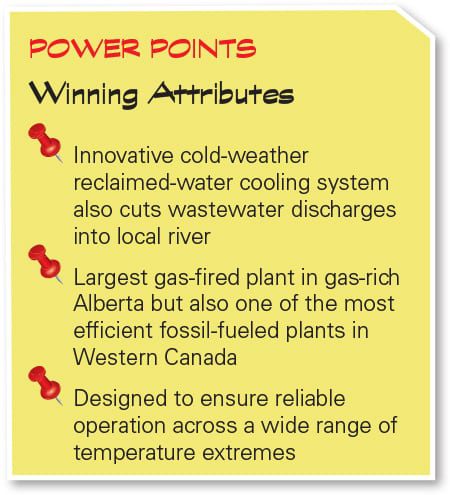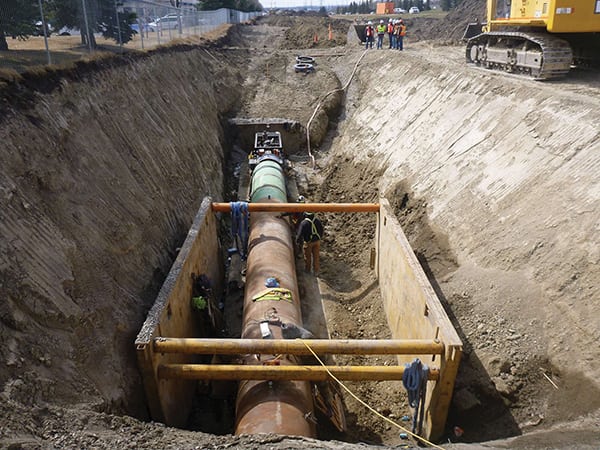Owners/operator: ENMAX and Capital Power/ENMAX
Faced with an impending wave of coal plant retirements, Calgary utility ENMAX set out to build the largest, most efficient, most environmentally friendly power plant in Alberta. Along the way, it developed an innovative cold-weather reclaimed-water cooling system that helped cut wastewater discharges into a local river.
As with many areas in North America and Europe, electricity generation in the Canadian province of Alberta is in transition toward cleaner, more efficient, more water-wise power. According to statistics from the provincial Ministry of Energy, as of September 2014, 43% of Alberta’s installed capacity was coal-fired, 40% was from gas, and the balance came from renewables.
But that mix is changing rapidly, in part because of concerns with air quality in a region so dependent on fossil fuels. Up to 60% of its 14.6-GW total capacity is set to be replaced over the next 15 years as its coal plants are retired, and much of that new capacity will be gas-fired. Making that transition smoothly in an area with sensitive environmental concerns and dramatic extremes of weather will require leadership from the province’s generators and policymakers.
Calgary-based ENMAX is a vertically integrated utility that has been serving the city for more than 100 years, beginning as the City of Calgary Electric System, which opened the first city-owned power plant in 1905. That municipal utility served Calgary until the province deregulated in the 1990s, and it was reorganized as ENMAX, a wholly owned subsidiary of the city, in 1998.
Though ENMAX’s generating capacity is a mix of gas and wind, it purchases a substantial amount of coal-fired electricity on the wholesale market. In the 2000s, ENMAX recognized that its small fleet of natural gas–fired plants in the Calgary area would not be enough to meet its needs, especially with the number of coal-fired plants slated for retirement because of Canadian federal greenhouse gas emissions regulations. It needed to secure its fleet for the future, and the decision was made to “think big.” One move was the acquisition in 2008 of the 320-MW combined cycle Calgary Energy Centre, but even more would be necessary.
 |
Development and Construction
ENMAX began drawing up plans for one of the largest power plants in Alberta, a state-of-the-art combined cycle facility that would also be one of the most efficient and environmentally friendly fossil fuel–fired generating resources in Western Canada.
Plans for the project were announced in 2007, and in 2008 Mitsubishi Heavy Industries (now Mitsubishi Hitachi Power Systems, MHPS) was tapped to provide two 501G gas turbines. Alberta Utilities Commission issued permission to proceed in November 2010.
A joint venture between Black & Veatch Canada and Kiewit Energy Canada helped ENMAX and MHPS refine the scope and budget for the project, and it was eventually awarded the engineering, procurement, and construction contract. Owner’s engineering was provided by Burns & McDonnell, and Hatch/Sargent Lundy performed the siting study and power island specifications. Ground was broken in June 2011, with construction beginning in October.
ENMAX’s large ambitions also meant a large price tag—C$1.4 billion. Though it could have financed the plant on its own, doing so would have slowed development of other projects it had planned. In 2012, ENMAX found a partner in Edmonton-based generator Capital Power, which owns about 3.2 GW of capacity across North America. Capital Power agreed to purchase a 50% interest in the Shepard Energy Centre, and the two companies formed a 50/50 joint venture partner arrangement to build, own, and operate the plant.
First firing of the turbines was achieved in August 2014, and commercial operations began the following March. In all, more than 4.3 million man-hours were expended on the project, which was completed on time and on budget with zero lost-time accidents. Craft labor peaked at 950, of which 90% were based in Alberta.
The Shepard Energy Centre is an 800-MW, two-unit combined cycle plant, making it the largest gas-fired power plant in Alberta—large enough to supply more than half the electricity used in Calgary. Two 240-MW MHPS 501G gas turbines feed two duct-fired Vogt Power International triple-pressure heat-recovery steam generators, which feed a single 320-MW MHPS reheat steam turbine, all of these provided as part of MHPS’s Power Island.
Cooling is provided by a Thermal Engineering International wet surface condenser and a cooling tower supplied by International Cooling Tower. Selective catalytic reduction, also supplied by Vogt, is used to keep NOx emissions at 3 ppm. The plant manages an impressive 6,221 kJ/kWh net heat rate.
A video about the plant is available at https://youtu.be/Tk5U3MEhoI0.
Challenges
Several key goals had to be met in building the plant.
The southern Alberta grid requires that power plants in the Calgary area be designed in a manner such that no single failure mode causes an instantaneous loss of more than one generator to ensure grid stability. Because of this, additional control system redundancy was built in to ensure the entire facility will not go offline at once.
The next constraint was the extreme ambient weather conditions. Weather in the Calgary area is notoriously unpredictable, often experiencing 20F- to 30F-degree temperature swings in a few hours, as a result of the region’s Chinook winds. Temperatures in the summer can exceed 90F while falling well below 0F in the winter. The area is also subject to violent summer thunderstorms, often accompanied by hail, and heavy snow in the winter.
As a result, the plant had to be engineered to withstand prolonged freezing temperatures in the winter while still operating efficiently in hot weather. The plant’s design basis is –40C. Underground ducting and piping had to be buried at least 2.7 meters below the surface to prevent frost upheaval. Where this was not possible, piping was protected with thermal board. All outdoor equipment, such as condensers, transformers, and air intakes, had to be designed for reliable operation in sub-zero weather.
Weather concerns affected another key constraint, which was minimizing the environmental impact. Rather than draw on area freshwater resources, ENMAX decided to use reclaimed water for process and cooling needs. The plant takes up to 14 million liters per day of tertiary output from Calgary’s Bonnybrook Wastewater Treatment Plant through a 14-kilometer underground pipeline (Figure 1). Once at the site, it’s purified further before use. This makes Shepard the first power plant in Alberta to use reclaimed water.
The water sensitivity doesn’t end with the intake. Rather than being discharged into the area watershed, site runoff is directed into a detention pond using a bioswale process, whereby the water naturally percolates back into the ground. In addition to avoiding added stress on freshwater supplies, this approach also reduced wastewater discharge into the Bow River, which is a key local water resource. Again because of the winter weather, the reclaimed water pipeline had to be buried below the frost zone.
The final constraint was the location of the site, which is in a new mixed-use industrial park within city limits. That meant extra efforts were necessary to reduce plant noise as well as the visual impact of the facility.
Looking Ahead
The Shepard Energy Centre is ahead of the curve on future demand, but that won’t last forever. It’s currently supplying about 7% of demand on the area grid, but with much of the province’s 3,600 MW of coal-fired power slated for retirement, more will have to be done. Through another joint venture, ENMAX and Capital Power are currently developing an even larger gas-fired plant near Edmonton: the proposed 1,060-MW Genesee 4 and 5 project.
“With the increasing demand for electricity in Alberta, ENMAX set a course to meet that need by providing cleaner, more efficient electricity generation to Albertans. The natural gas–fuelled Shepard Energy Centre adds 800 MW to the Alberta grid and reduces Alberta’s reliance on coal-fired generation,” Dave Rehn, ENMAX’s executive vice president, generation, told POWER. “We continue to develop plans to invest in natural gas and renewable generation to support Alberta’s transition to cleaner electricity sources.”
— Thomas W. Overton, JD is a POWER associate editor.
